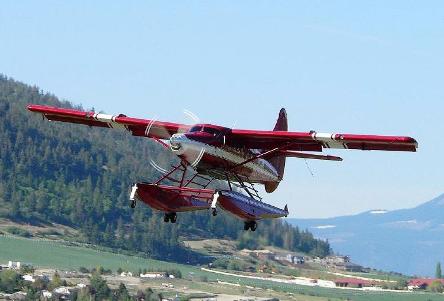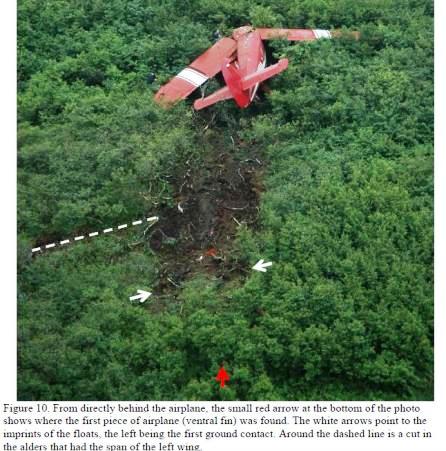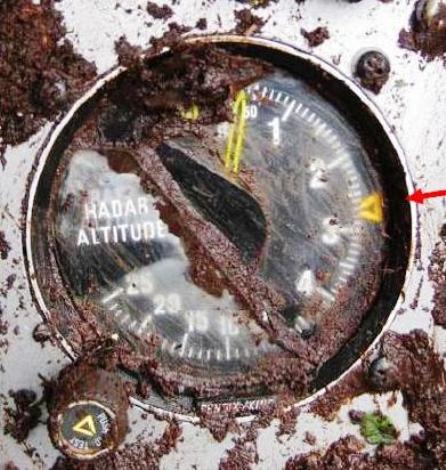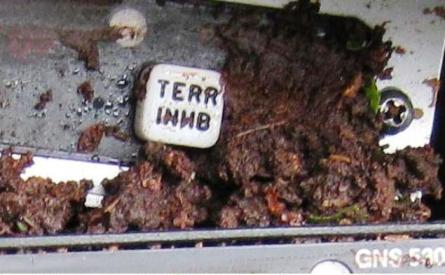A required terrain awareness and warning system (TAWS) on a de Havilland DHC-3T Otter that crashed on August 2010 in Alaska, killing former Sen Ted Stevens and four others, may have been turned off.
The information was included in trove of factual data released by the US National Transportation Safety Board (NTSB) on 21 April. Also killed in the accident was the pilot, Theron Smith. The four survivors include former NASA administrator Sean O'Keefe and his son.
 |
|---|
Crash location with departure point noted by arrow |
©NTSB |
While the basic evidence - a low pressure system causing low ceilings and marginal visual flight rules (VFR) conditions along the 52mi route - point to an all too familiar controlled-flight-into terrain (CFIT) after continued VFR into instrument flight rules (IFR) conditions scenario, the pilot's experience combined with the capabilities of the onboard TAWS avionics is raising broader questions about operational procedures and mental fitness.
 |
|---|
N455A in an earlier picture |
©NTSB |
Pilot Theron "Terry" Smith, a life-long Alaska pilot, logged 29,000h as a pilot for 28 years with Alaska Airlines, most recently as the Anchorage-based chief pilot, before he retired in 2007. He later worked for the ConocoPhillips petroleum company as head of the company's aviation unit in Alaska before taking a job flying for General Communications (GCI), the company that owned the lodges Smith was flying between on the day of the accident.
Smith lost his medical in 2006 after a "cerebral vascular event" (a minor stroke), but two years later had the medical reinstated after a "full recovery" but with the stipulation that "operation of aircraft is prohibited at any time new symptoms or adverse changes occur," according to the NTSB reports. Twelve days before the 9 August accident, Smith's son-in-law Aaron Malone was killed in a C-17 transport crash at the Elmendorf AFB. Malone, acting as "safety observer", was one of four on board who were practicing for an air show. The Air Force later attributed the accident to pilot error.
Smith had survived several close calls recently, according to the NSTB. In September 2009 he landed on a gravel road in a Grumman Widgeon "with minor damage and no injuries" after a dual engine failure in California. Five months before that, he experienced a complete power loss in a Piper PA-18A Super Cub in New Zealand, but was not injured in the forced landing.
On 9 August 2010, Smith was flying the group of eight from the GCI lodge to a fishing outpost, with a return planned that evening. Earlier that morning, Smith had determined a flight to the outpost was not possible due to turbulence and low ceilings. "However, after finishing lunch, which was about 1400 (2:00pm), the pilot informed the lodge coordinator who was in charge of coordinating the flights to the fishing camp, that the weather had lifted and he was comfortable taking a group to the fishing camp if they wanted to go," the NTSB says.
 |
|---|
Tracking date from flight path (red) starting at GCI Lodge (top left) |
©NTSB |
The turbine-powered Otter impacted the western slope of the Muklung Hills, peak altitude of 2,550ft, as it proceeded along its south-easterly route, approximate 18mi after the takeoff point and at an altitude of approximately 900ft mean sea level (MSL). Weather reports from an airport 18mi south of the accident site was wind direction of 140° (magnetic), wind speed of 13kt with gusts to 18kt; broken cloud base at 700ft AGL with overcast cloud base at 1,300ft. VFR (Part 91) rules in the area and below 1,200ft AGL altitude require at least 1mi visibility and that the pilot to remain clear of clouds.
 |
|---|
©NTSB |
One survivor recalled seeing only "white-out conditions outside the airplane. He did not know if the airplane had climbed into clouds initially or if it had entered clouds at some point along the way," the NTSB reports.
An analysis of the impact zone and other materials leads investigators to believe the pilot had performed an escape manoeuvre just before the crash in an attempt to avoid terrain. Based on evidence that the ventral fin located beneath the aircraft had broken from the aircraft first, followed by impact by the left float, investigators determined a pitch attitude of 17° nose up and 30° roll to the left. Investigators considered that a Honeywell radar altimeter alert set for 275ft may have sounded, initiating the pull-up and bank response by the pilot.
 |
|---|
©NTSB |
After the crash, the Artex emergency locator transmitter did appear to activate; however the unit had separated from its antenna lead, preventing the signal from broadcasting to search and rescue aircraft and satellite monitors. Search and rescue operations began later in the day after GCI officials began expecting the group's return. Rescue operations to extract the survivors occurred the following day.
A Garmin GNS-530 navigation/communication system with terrain warning awareness system (TAWS), a safety feature required for Part 91 aircraft with six or more seats, may not have been activated. An inhibit switch, required by law, was found to be in the active position, which would have removed the look-ahead terrain function as well as the terrain display and audio warnings. The purpose of the terrain inhibit function is to allow aircraft to operate "without nuisance or unwanted warnings at airports that are not in the system database", according to one avionics manufacturer's web site.
 |
|---|
©NTSB |
When powered-up by the NTSB, the Garmin 530 with the terrain inhibit removed clearly showed the crash location in the midst of "red" terrain, meaning terrain that is higher than the aircraft.
 |
|---|
©NTSB |
The NTSB did not draw any conclusions from the released data but plans to issue a probable cause and recommendations during a public meeting on the accident on 24 May.
Source: Flight International



















